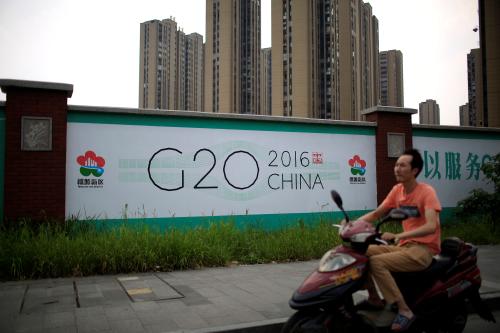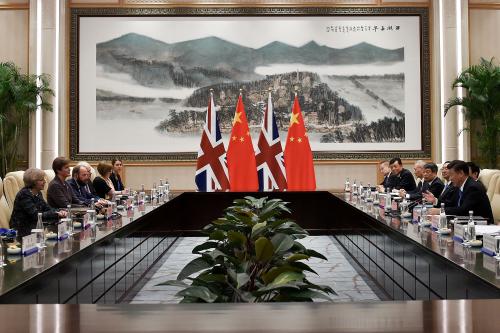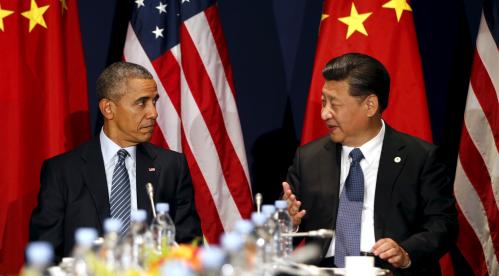Content from the Brookings-Tsinghua Public Policy Center is now archived. Since October 1, 2020, Brookings has maintained a limited partnership with Tsinghua University School of Public Policy and Management that is intended to facilitate jointly organized dialogues, meetings, and/or events.
Originally an annual meeting of finance ministers and central bank governors, the G-20 became a forum for world leaders in response to the 2008 financial crisis. With its members’ economies accounting for roughly 85 percent of global GDP, the G-20 is a more representative body than the G-7. But crafting the G-20 into an effective mechanism of global governance—rather than crisis management—remains a work in progress. As the largest economy outside of the G-7, China understandably has a keen interest in elevating the status of this forum.
When China hosts the G-20 leaders’ summit in Hangzhou on September 4 and 5, it will be an important chance for the country to demonstrate that it has convening power on the world stage and that its participation is essential to solving global challenges. Although these goals are intertwined, organizing a well-attended G-20 summit is important primarily as a precursor to leading a productive meeting. It is on this latter metric—China’s ability to mobilize fellow G-20 members into collective action—that the success of the Hangzhou summit will ultimately be measured.
China, the organizer
The Hangzhou summit is an opportunity for China to project to leaders of G-20 countries—and to the world—that it takes global governance seriously and that its organizing and convening capacities are second to none. On the organizational front, China is applying the meticulous formula it used to successfully host the 2008 Beijing Olympics. A series of pre-summit meetings for ministers and sherpas have proceeded smoothly, with China using these events to showcase some of its other preeminent cities—from Xiamen to Guangzhou, and Nanjing to Chengdu.
Meanwhile, the government has worked tirelessly to beautify Hangzhou and refine the city’s infrastructure in the lead-up to September. The preparations are as detailed as they are comprehensive. Reportedly, factories have even been ordered to paint their rooftops gray to appear more attractive in drone footage. And planners have arranged 760,000 volunteers for the summit, dwarfing the 50,000 volunteers registered for the entire Rio Olympics.
Leaders from all G-20 countries—as well as from several guest countries and international organizations—plan to attend the summit, an implicit expression of confidence in China’s leadership potential. Despite the complex crises roiling many regions and the mounting skepticism in some developed economies toward globalization and international institutions, G-20 leaders believe that the Hangzhou summit will be worthwhile.
The Hangzhou summit is an opportunity for China to project to leaders of G-20 countries—and to the world—that it takes global governance seriously.
China, the mobilizer
A well-attended leaders’ summit sets the stage for China’s more daunting challenge, which is to facilitate a productive meeting. This is a uniquely high-profile occasion for China to illustrate that it is indispensable to an effective, progressive global governance system. In a letter posted online in December 2015, President Xi Jinping articulated his view of the 2016 summit’s themes and key agenda items, highlighting the need for “an action-oriented G20.” Managing the fallout from Brexit will inevitably consume a portion of leaders’ attention in Hangzhou. But there are several other important areas in which positive input and decisive actions from China could yield meaningful results. These range from setting a broad, long-term strategic vision to solving acute, short-term challenges. Collectively, these accomplishments would showcase the dynamic contribution China can make to global governance.
At the “broad” end of the spectrum is the U.N.’s 2030 Agenda for Sustainable Development. China has emphasized its commitment to the 2030 Agenda, asserting that G-20 members should lead its implementation. In late May, Foreign Minister Wang Yi urged that development be given priority at the Hangzhou summit, echoing Xi’s earlier call for the G-20 to “take its unique advantage to provide a package of solutions to real problems.” The G-20’s agreement on an action plan for implementing the 2030 Agenda—especially one that emphasizes infrastructure investment—would be a big win for China, demonstrating its ability to marshal support for a long-term strategic plan. It would also help set the G-20’s direction for the next decade-and-a-half and ensure that China holds a spot at the helm.
By contrast, an acute challenge that is ripe for resolution is overcapacity in the steel sector. Not only is steel overcapacity relevant to growing anti-globalization sentiment in developed countries, but, perhaps more important, it is a problem that China can solve almost on its own. According to the latest data from the World Steel Association, China has produced half the world’s supply of steel so far this year. In a communiqué delivered after their late-July meeting in Chengdu, the G-20 finance ministers declared that “excess capacity in steel and other industries is a global issue which requires collective responses.” China’s commitment to reducing its domestic capacity would demonstrate its willingness to, when necessary, prioritize global balance over domestic optimization.
Global trade presents an opportunity for blending strategic vision-setting with acute problem-solving. Specifically, China can play a central role in pushing forward the Environmental Goods Agreement (EGA) and accelerating G-20 countries’ implementation of the Information Technology Agreement (ITA) expansion. Xi highlighted both priorities in his December 2015 letter and, after their July meeting in Shanghai, G-20 trade ministers announced “substantial progress” in negotiations over the EGA, anticipating that a “landing zone” could be reached by the Hangzhou summit. Helping finalize the EGA and speed implementation of the ITA expansion would reaffirm China’s commitment to and positive impact on global trade and sustainable global growth.
There is no shortage of global challenges for which China can assume greater responsibility in driving consensus and progress. Other priority areas include global anti-corruption, tax evasion, cybersecurity, and the ongoing refugee crisis in Europe. Either through building support around a balanced multilateral strategy, offering singular commitments, or some combination of the two, China can further establish its role as a leader of the G-20 and a devoted member of the international community.
The world already knows China’s talents as a planner, and the Hangzhou summit appears likely to extend that impressive legacy. But unlike other events for which seamless logistics are the end-goal, organization is merely a starting point when it comes to global governance. Given the attention of world leaders—each of whom must navigate divergent national interests and attend to complex domestic concerns—China’s critical test lies in whether or not it can direct that energy to productive ends.
Against this backdrop, China’s leaders must calculate what concessions they are willing to offer—and what short-term costs they are content to bear—in order to help facilitate a productive G-20 leaders’ summit in Hangzhou. Doing so would substantiate the country’s desire to play a more central role in global governance, driving the case for shifting influence away from the G-7 and toward a results-oriented G-20. And a position at the center of a G-20-led global governance framework could reap significant benefits for China as it strives to achieve its longer-term goals.
The Brookings Institution is committed to quality, independence, and impact.
We are supported by a diverse array of funders. In line with our values and policies, each Brookings publication represents the sole views of its author(s).







Commentary
How will China’s success at the G-20 summit be measured?
August 29, 2016